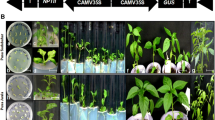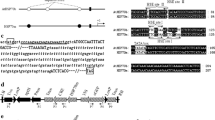Abstract
Agrobacterium tumefaciens strain EHA105 harboring an ipt-type MAT vector, pNPI132, was used to produce morphologically normal transgenic Nierembergia caerulea cv. Mont Blanc employing ipt gene as the selectable marker gene. β-glucuronidase (GUS) gene was used as model gene of interest. The MAT vector system is a positive selection system that gives the advantage of regeneration to the transgenic cells without killing the non-transgenic cells. Infected explants were cultured on hormone- and antibiotic-free MS medium, and 65% of the regenerated shoots developed ipt shooty phenotype-morphologically abnormal shoots, within approximately 3 months after co-cultivation. Twenty morphologically normal shoots were produced from 12 transgenic ipt shoots 7 months after co-cultivation. The normal shoots rooted well on hormone-free MS medium. Ninety percent of the normal shoots were ipt −, GUS+ and excision+ as determined by PCR and Southern blot analyses. These results indicate that ipt-type MAT vector system can be used successfully in Nierembergia to produce marker-free transgenic plants without using phytohormones and selective chemical agents.





Similar content being viewed by others
Abbreviations
- ESP:
-
Extreme shooty phenotype
- GUS:
-
β-Glucuronidase
- ipt :
-
Isopentenyl transferase
- MAT:
-
Multi-auto-transformation
References
Araki H, Jearnpipatkul A, Tatsumi H, Sakurai T, Ushino K, Muta T, Oshima Y (1987) Molecular and functional organization of yeast plasmid pSR1. J Mol Biol 182:191–203
Ditta G, Stanfield S, Corbin D, Helinski DR (1980) Broad host range cloning system for gram negative bacteria: Constuction of gene bank of Rhizobium meliloto. Proc Natl Acad Sci USA 77:7374–7351
Ebinuma H, Sugita K, Matsunaga E, Yamakado M (1997) Selection of marker-free transgenic plants using the isopentenyl transferase gene as a selectable marker. Proc Natl Acad Sci USA 94:2117–2121
Ebinuma H, Sugita K, Matsunaga E, Endo S, Kasahara T (2000) Selection of marker-free transgenic plants using the oncogenes (IPT, ROL A, B, C) of Agrobacterium as selectable markers. In: Jain SM, Minocha SC (eds) Molecular biology of woody plants II. Kluwer Academic Publishers, Dordrecht, Netherlands pp 25–46
Ebinuma H, Komamine A (2001) MAT (multi-auto-transformation) vector system. The oncogenes of Agrobacterium as positive markers for regeneration and selection of marker-free transgenic plants. In Vitro Cell Dev Plant 37:103–113
Endo S, Kasahara T, Sugita K, Matsunaga E (2001) The isopentenyl transferase gene is effective as a selectable marker gene for plant transformation in tobacco (Nicotiana tabacum cv. Petite Havana SRI). Plant Cell Rep 20:60–66
Endo S, Kasahara T, Sugita K, Ebinuma H (2002) A new GST-MAT vector containing both ipt and iaaM/H genes can produce marker-free transgenic tobacco plants with higher frequency. Plant Cell Rep 20:923–928
Godo T, Tsujii O, Ishikawa K, Mii M (1997) Fertile transgenic plants of Nierembergia scoparia Sendtner obtained by a mikimopine type strain of Agrobacterium rhizogenes. Sci Hort 68:101–111
Hobbs SLA, Warkentin TD, Delong CMO (1993) Transgene copy number can be positively or negatively associated with transgene expression. Plant Mol Biol 21:17–26
Horsch RB, Fry JE, Hoffman NL, Eichhholtz D, Rogers SG, Fraley RT (1985) A simple and general method for transferring genes into plants. Science 227:1229–1231
Jefferson RA (1987) Assaying chimeric genes in plants: the GUS gene fusion system. Plant Mol Biol Rep 5:387–405
John MC, Amasino RM (1989) Extensive change in DNA methylation patterns accompanies activation of a silent T-DNA ipt gene in Agrobacterium tumefaciens-transformed plant cells. Mol Cel Biol 9:4298–4303
Matsuzaki H, Nakajima R, Nishiyama J, Araki H, Oshima Y (1990) Chromosome engineering in Saccharomyces cerevisiae by using a site-specific recombination system of a yeast plasmid. J Bacteriol 172:610–618
Matzke MA, Matzke AJM, Scheid OM (1994) Inactivation of repeated genes—DNA–DNA interaction? In: Paszkowski J (ed) Homologous recombination and gene silencing in plants. Kluwer, Dordrecht, pp 271–307
Mette MF, Aufsat ZW, van der Winden J, Matzke MA, Matzke AJM (2000) Transcriptional silencing and promoter methylation triggered by double-stranded RNA. EMBO J 19:5194–5201
Mette MF, van der Winden J, Matzke MA, Matzke AJM (1999) Production of aberrant promoter transcripts contributes to methylation and silencing of unlinked homologous promoters in trans. EMBO J 18:241–248
Murashige T, Skoog F (1962) A revised medium for rapid growth and bioassays with tobacco tissue cultures. Physiol Plant 15:473–497
Onouchi H, Yokoi K, Machida C, Matsuzaki H, Oshima Y, Matsuoka K, Nakamura K, Machida Y (1991) Operation of an efficient site-specific recombination system of Zygosaccharomyces rouxii in tobacco cells. Nucl Acids Res 19:6373–6378
Rogers OS, Bendich JA (1988) Extraction of DNA from plant tissues. In: Gelvin SB, Schiliperoort RA, Verma DPS (eds) Plant molecular biology manual, vol. A6., Kluwer Academic Publishers, Dordrecht Boston London, pp, 1–10
Sawahel WA (1994) Transgenic plants: performance, release and containment. World J Microbiol Biotech 10:139–144
Smigocki AC, Owens LD (1988) Cytokinin gene fused with a strong promoter enhances shoot organogenesis and zeatin levels in transformed plant cells. Proc Natl Acad Sci USA 85:5131–5135
Shizukawa Y, Mii M (1997) A simple and efficient plant regeneration system for leaf protoplasts of Nierembergia repens by inducing single shoots on the microcolonies. Plant Cell Rep 16:545–549
Sugita K, Matsunaga E, Ebinuma H (1999) Effective selection system for generating marker-free transgenic plants independent of sexual crossing. Plant Cell Rep 18:941–947
Sugita K, Matsunaga E, Kasahara T, Ebinuma H (2000) Transgene stacking in plants in the absence of sexual crossing. Mol Breed 6:529–536
Yoder JI, Goldsbrough AP (1994) Transformation systems for generating marker-free transgenic plants. Biotechnology 12:263–267
Acknowledgement
The authors would like to thank Dr. H. Ebinuma, Pulp and Paper Research, Nippon Paper Industries, Tokyo for providing the MAT vector constructs.
Author information
Authors and Affiliations
Corresponding author
Additional information
Communicated by H. Ebinuma
Rights and permissions
About this article
Cite this article
Khan, R.S., Chin, D.P., Nakamura, I. et al. Production of marker-free transgenic Nierembergia caerulea using MAT vector system. Plant Cell Rep 25, 914–919 (2006). https://doi.org/10.1007/s00299-006-0125-6
Received:
Revised:
Accepted:
Published:
Issue Date:
DOI: https://doi.org/10.1007/s00299-006-0125-6




